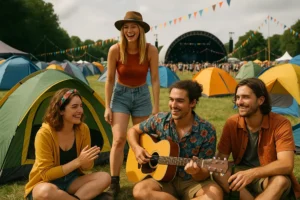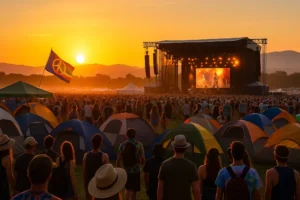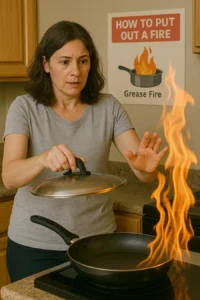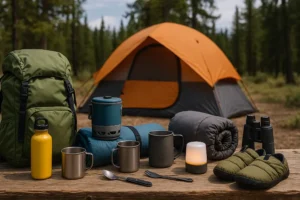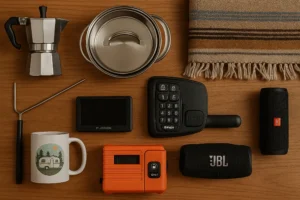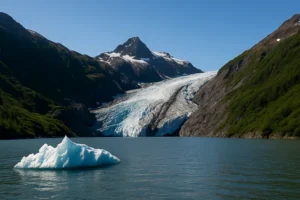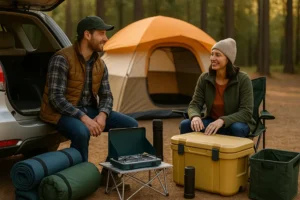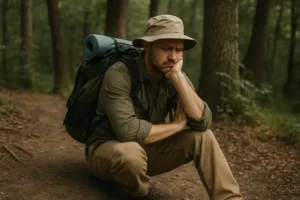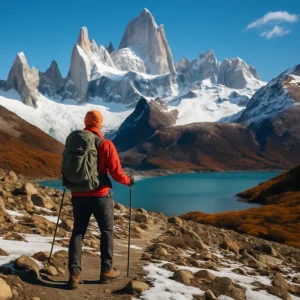There’s something magical about fall camping. Crisp air. Fewer crowds. Vibrant foliage that turns even the simplest trail into a cinematic masterpiece. While most folks hang up their gear after summer, seasoned adventurers know that autumn is the sweet spot for exploration. Fewer bugs, cooler nights, and crackling campfires? Yes, please.
If you’re chasing the ultimate fall camping trip—one that delivers both solitude and splendor—you’re in the right place. These seven fall camping getaways are more than just pretty places. They’re transformational escapes, offering everything from alpine lakes to golden aspens to moose sightings. Let’s dig in.
1. Fall Creek Falls State Park – Tennessee
Fall Creek Falls isn’t just a name—it’s a showstopper. At 256 feet, it’s the highest free-fall waterfall east of the Mississippi, and in the fall, the surrounding canopy erupts in shades of amber, crimson, and burnt orange.
Why it’s perfect for fall camping:
The park’s elevation keeps temperatures comfortably cool, especially from late September through November. Wake up to mist drifting off the lake and end the day with stargazing you won’t get in summer’s humidity.
Camping tip:
Snag a lakeside site at the main campground (sites 1–75). They offer easy access to trails and views that’ll make your morning coffee taste better.
Don’t miss:
The Gorge Overlook Trail. It’s short but packs a visual punch—especially in peak leaf season.
2. Isle Royale National Park – Michigan
Remote. Rugged. Raw. And entirely surrounded by Lake Superior. Isle Royale isn’t just a destination—it’s a commitment. You can only get there by ferry or seaplane, and once you’re in, you’re really in. No cars. No crowds. And no cell service. Just wilderness.
Why it’s perfect for fall camping:
Mid-September offers a last call for backpackers before the park closes in October. By then, the mosquitoes are gone, the air is brisk, and the trails are practically yours.
Camping tip:
Bring your own water filter and layers. The temperatures swing wildly here—from sunny 60s in the day to frost-kissed nights.
Pro move:
Hike the Greenstone Ridge Trail. It spans the island and offers panoramic views you’ll be dreaming about all winter.
3. Gunnison National Forest – Colorado
Colorado’s fall color game is unmatched. And Gunnison National Forest, sitting quietly in the shadows of the Rockies, brings the gold. Aspen groves explode into fiery yellow, while the jagged peaks remain dusted with early snow.
Why it’s perfect for fall camping:
With over 1.6 million acres, you won’t struggle to find solitude. Late September is prime time. Think warm days for hiking, cold nights perfect for fires, and no summer crowds.
Camping tip:
Set up basecamp near Kebler Pass—it’s one of the largest aspen stands in the world. Dispersed camping is allowed here, so you’ll get jaw-dropping views without a reservation.
Gear note:
Pack layers and a reliable sleeping pad. Temps can dip below freezing, and you’ll want insulation from the cold ground.
4. Carson National Forest – New Mexico
New Mexico might not scream “fall,” but Carson National Forest begs to differ. High elevation, sweeping meadows, and golden aspens make it one of the Southwest’s most underrated fall camping spots.
Why it’s perfect for fall camping:
You get elevation without extreme weather. September and October are peak months for both foliage and clear skies.
Camping tip:
Head toward the Rio Costilla area for tranquil, lesser-known campsites. Wildlife is active, especially elk—so keep your camera (and bear bag) handy.
Must-do:
Hike Wheeler Peak, the highest point in the state. It’s a challenge, but the views of red-orange valleys from 13,000 feet? Unreal.
5. Desolation Wilderness – California
Despite the name, Desolation Wilderness feels alive in the fall. This granite-studded alpine region near Lake Tahoe is dotted with sapphire lakes and fiery red huckleberry bushes. If solitude and silence top your wishlist, this is your sanctuary.
Why it’s perfect for fall camping:
Once Labor Day ends, so do the crowds. The crisp air and crystal-clear lakes make backpacking here in September and early October a dream.
Camping tip:
You’ll need a permit, but it’s worth it. Start at Echo Lakes Trailhead and camp near Lake Aloha. You’ll feel like you’ve entered another planet.
Bonus insight:
Desolation’s granite slabs can be brutal on your feet. Sturdy boots and thick socks will save your soles.
6. Pine Grove Furnace State Park – Pennsylvania
This one’s for the East Coasters who want a perfect weekend escape. Located in the northern tip of the Blue Ridge Mountains, Pine Grove Furnace State Park delivers dense woods, vivid colors, and historical charm.
Why it’s perfect for fall camping:
Mid-October is peak foliage. And the Appalachian Trail runs right through the park, offering up bucket-list bragging rights even on a day hike.
Camping tip:
Campground A is wooded and quiet. Bring a hammock—this is hammock country.
Fun fact:
It’s home to the halfway point of the Appalachian Trail. Stop by the museum or, if you’re brave, attempt the half-gallon ice cream challenge just like thru-hikers do.
7. Canyonlands National Park – Utah
This place is Mars meets fall. While it’s not known for trees or changing leaves, Canyonlands National Park offers something better: comfortable weather, golden sunlight, and fiery desert tones that feel like autumn in their own right.
Why it’s perfect for fall camping:
September to November is prime. The searing summer heat fades, leaving behind perfect 70-degree days and chilly nights ideal for stargazing.
Camping tip:
The Needles District offers the most diverse terrain and fewer crowds. Sites like Squaw Flat (first-come, first-served) are ideal for day hikes and slickrock views.
Hiker’s dream:
Take the Chesler Park Loop. It’s otherworldly. You’ll navigate rock fins, slot canyons, and towering spires.
Fall Camping Tips You Shouldn’t Skip
Let’s be real: fall camping isn’t summer camping with sweaters. There are unique considerations that make or break your trip.
1. Always pack layers.
Even if it’s 70 at noon, it can dip below 40 by midnight. Think base layer, fleece, puffer, and windbreaker. And don’t forget gloves and a beanie.
2. Bring fire-starting gear.
Wet leaves and cold mornings? Not fun without fire. Pack waterproof matches, a firestarter stick, or even a mini propane torch.
3. Know the daylight hours.
Fall days are shorter. Plan your hikes early, and pitch your tent before you lose the sun.
4. Prep your sleep system.
Use an insulated sleeping pad. Combine a 20°F-rated sleeping bag with a liner for extra warmth. A hot water bottle tucked into your bag? Game-changer.
5. Check regulations and closures.
Some parks and trails close seasonally. Always double-check before you go, especially in remote areas.
Final Thoughts
Fall camping isn’t just about escaping the heat. It’s about tapping into the rhythm of the season—slowing down, cozying up, and getting closer to the wild. The trails are quieter, the stars are brighter, and the world feels just a little more alive.
Whether you’re trekking through golden aspens in Colorado or soaking in desert silence in Utah, these fall camping getaways will leave you with stories worth telling.
So zip up your jacket, pack the cocoa, and get out there. Autumn won’t wait.
Fall Camping FAQs
Yes, as long as you prepare for cooler temperatures and shorter daylight. Pick well-maintained trails and established campgrounds.
Late September to mid-October is ideal in most parts of the U.S. It offers peak foliage and manageable weather.
Some places allow dispersed camping or first-come, first-served spots. But popular destinations still fill up—check ahead.
Layers, insulated sleeping gear, fire-starting tools, headlamp, and extra food. Be ready for sudden temperature drops.
Often, yes. Some allow free dispersed camping, while others require a backcountry or overnight permit.
Yes. Fall is prime feeding season before hibernation, so follow all food storage regulations.
It depends! If you like solitude, crisp air, fewer bugs, and vibrant colors—yes, fall camping is unbeatable.


